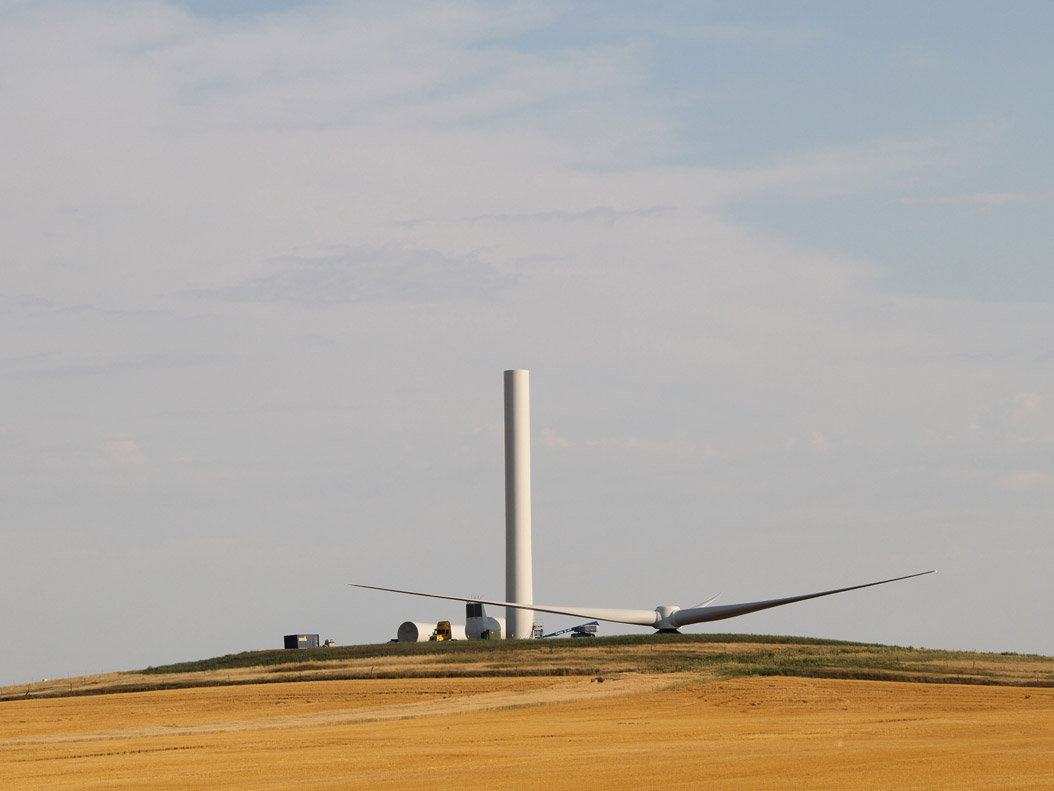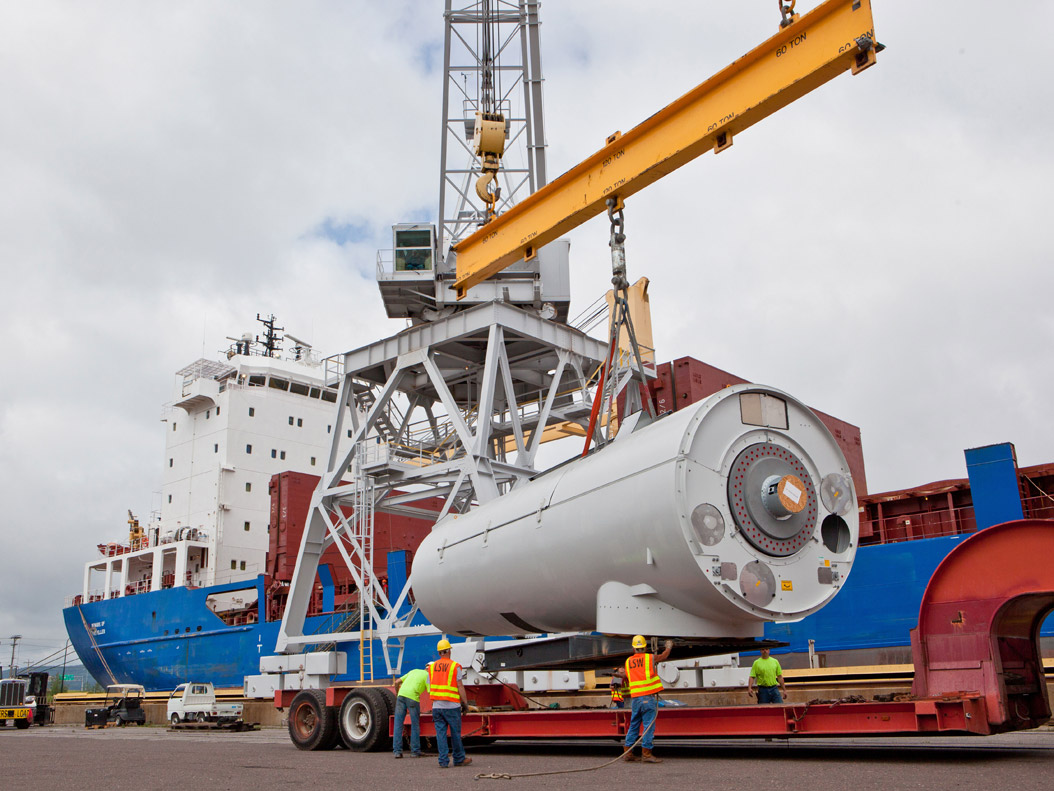What wind power is:
- Wind power is power created by changing the energy of the wind into a useful form of energy.
- Wind turbines convert the kinetic energy of wind into mechanical and then electrical energy.
- Wind is the movement of air from an area of high pressure to an area of low pressure.
High pressure is an area of sinking air caused by air converging higher up in the atmosphere. Low pressure is an area of rising air caused by air converging at the earth's surface.
Anemometer: A weather vane is a device used to monitor wind direction. An anemometer (an-ah-MOM-ah-ter) is an instrument used to measure wind speed
- Warm air, which weighs less than cool air, rises; cool air moves in and replaces the rising warm air.
- Because of the earth's rotation, the air is also deflected clockwise (in the Northern Hemisphere).
- Wind results because nature strives to balance and equalize pressure from one area to another.
- Wind is generated naturally and is one of the cleanest sources of energy.
- Francis Beaufort, an admiral in the Irish Navy, created a wind force scale in 1806 that indicated how much of a ship's sails would be used under each wind condition. The scale has been adapted for observed conditions on land but is still known as the Beaufort Scale.
Force Wind Scale Force Description Wind Speed (mph) Observable Effects 0 calm less than 1 smoke goes straight up 1 light air 1-3 slight smoke drift 2 light breeze 4-7 leaves gently rustle 3 gentle breeze 8-12 leaves and small twigs move 4 moderate breeze 13-18 dust is raised; small branches move 5 fresh breeze 19-24 small trees sway; waves on lakes 6 strong breeze 25-31 large branches sway; umbrellas difficult to use 7 near gale 32-38 trees sway; walking against wind is difficult 8 fresh gale 39-46 twigs break off trees; walking impeded 9 strong gale 47-54 branches snap; minimal damage of roofs, buildings 10 whole gale 55-63 trees uprooted; considerable damage of buildings 11 violent storm 64-72 widespread damage to buildings 12 hurricane 73 + widespread destruction
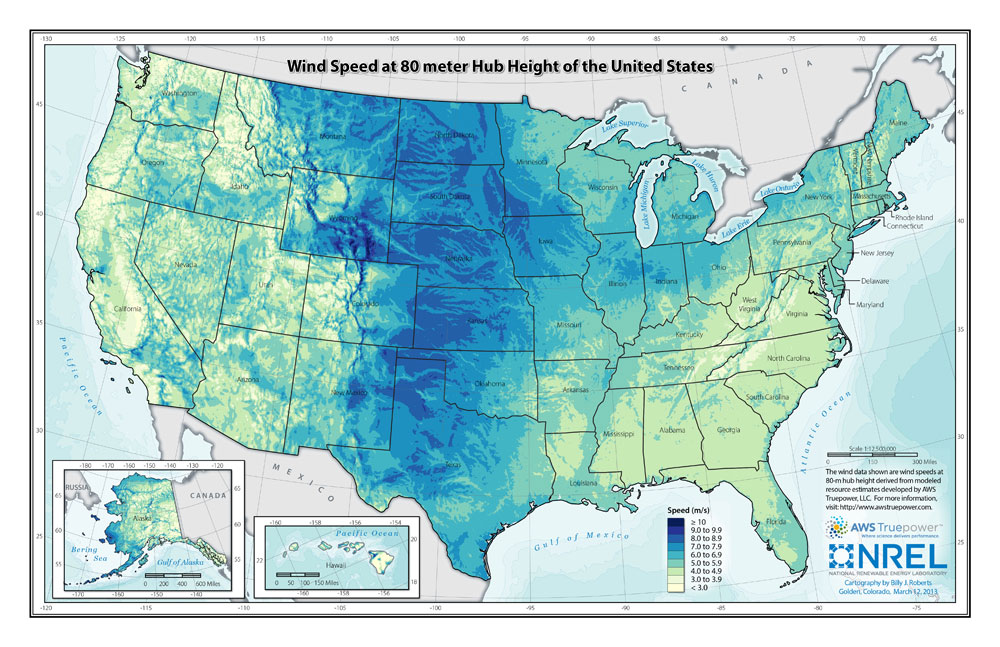
NREL Wind Resource US The wind resources in North Dakota rank sixth among all of the states in the United States. Wind resource map developed by NREL for DOE with data from AWS Truepower.
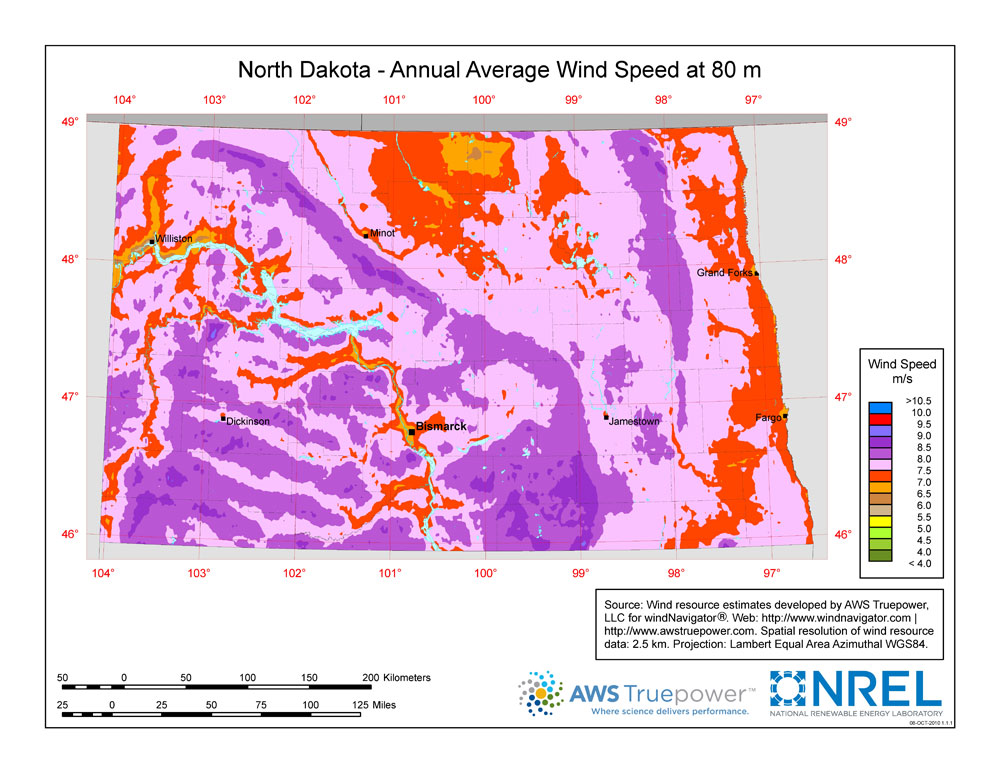
80M NREL Wind Resource ND A closer look at the wind potential in North Dakota. Wind resource map developed by NREL for DOE with data from AWS Truepower. Wind resource map developed by NREL for DOE with data from AWS Truepower.
Using wind power:
- Modern technology has made wind a more practical way of producing electricity.
- A group of wind turbines is called a wind farm
- Electricity from wind farms is conveyed by transmission lines to the electricity grid.
- The electricity grid is a network of connected power lines that carry electricity throughout the United States.
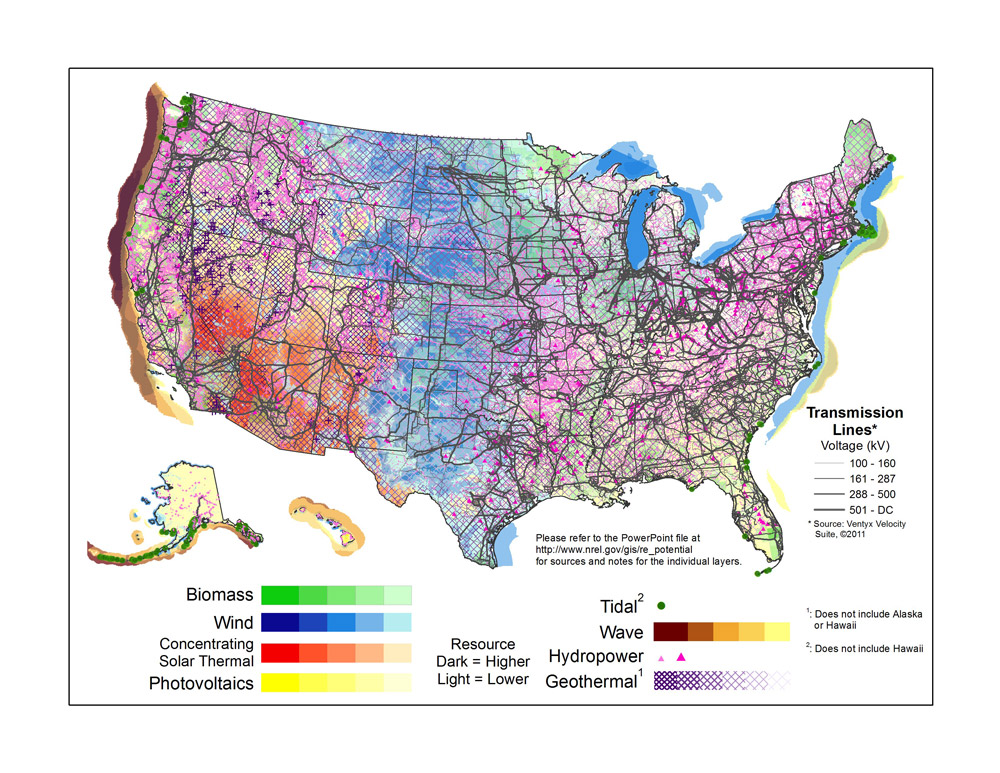
United States Power Grid and Renewables This map shows renewable energy potential along with high voltage transmission lines throughout the United States – from 100 kilovolts and up. The smaller distribution lines (wires the carry electricity to homes) are not shown on this map. Map courtesy of National Renewable Energy Laboratory.
Converting Wind to Electricity
Visit the Bismarck State College Animation Tool to see how a wind turbine generates electricity.
- Each wind turbine has a weather station at the top that tells the wind direction and wind speed.
- The information from this weather station is fed into the turbine's computer, which turns the nacelle and blades to face into the wind.
- Wind turns the blades, which are connected to a low-speed drive-shaft.
- The low-speed drive-shaft is connected to a large gear inside a gear box.
- The slow-moving large gear causes a small gear to turn rapidly.
- The rapidly-turning small gear spins a drive shaft at a high rate of speed.
- The high-speed drive shaft is connected to a generator, where magnets spin within wire coils to produce electricity.
- The electric current is sent through cables down the turbine tower to a step-up transformer at the base of the wind tower.
- The transformer steps up, or increases, the voltage for delivery through the transmission lines.
How Basin Electric builds a wind turbine Video courtesy of Basin Electric Power Cooperative.
History of wind power in North Dakota:
-
Early settlers in North Dakota used windmills on farmsteads to pump water from wells for livestock and household use.
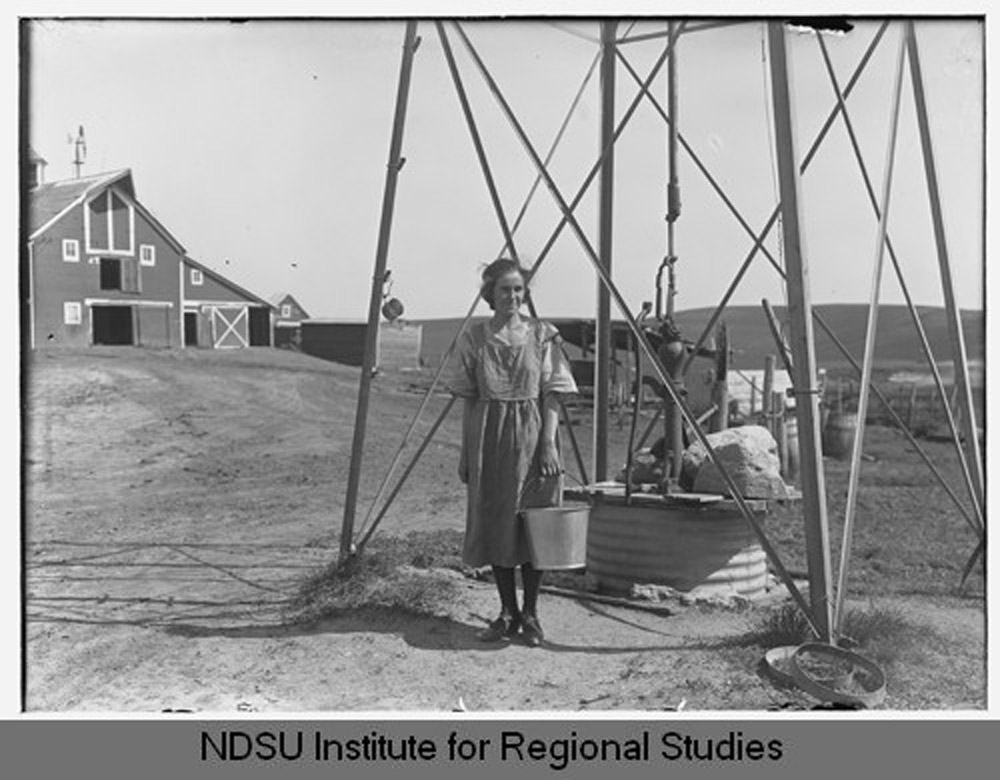 Settlers: This photo from 1922 shows a young woman in front of a windmill. Early settlers used windmills on farmsteads to pump water from wells. Photo courtesy of NDSU Institute for Regional Studies.
Settlers: This photo from 1922 shows a young woman in front of a windmill. Early settlers used windmills on farmsteads to pump water from wells. Photo courtesy of NDSU Institute for Regional Studies. - In the early 1900s, some North Dakota residents began using wind chargers to generate electricity for home lighting and small electrical devices.
- Generating electricity from wind chargers had severe limitations.
- Not enough power was generated to operate large electrical devices.
- Batteries were needed for electrical storage during times the wind was not blowing but had to be charged frequently to prevent loss of power.
- Some systems needed to use gasoline generators for additional backup power.
- Generating electricity from wind chargers had severe limitations.
- In the 1940s, electricity was brought to North Dakota farms by Rural Electric Cooperatives (RECs).
- By 1954, almost all of the farms in North Dakota had electricity brought by the RECs.
Wind power in North Dakota today:
- In recent years, wind power is again being used to generate electricity in North Dakota.
- The Benedictine Sisters of Sacred Heart Monastery near Richardton were wind energy pioneers in the state.
- In 1997, they installed two Silver Eagle turbines that are still in use today.
- The Benedictine Sisters of Sacred Heart Monastery near Richardton were wind energy pioneers in the state.
- Presently, North Dakota obtains more than 20 percent (2022) of its power from wind resources.
- Among all the states, North Dakota ranks 9th for installed wind capacity.
- More than 2,200 wind turbines are located throughout North Dakota.
-
Technology continues to improve in construction of wind towers. For example, some of the blades at Bison Wind Farm use "dino tails" – a spiked ridge on the blades used to reduce noise and make blades more efficient as they spin.
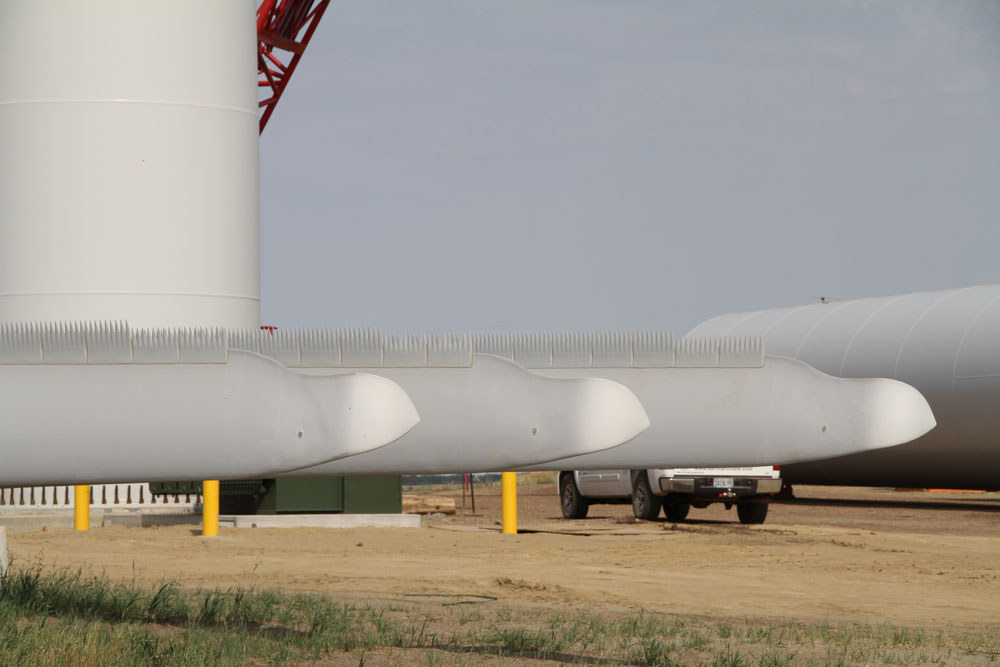 A close-up look at "Dino Tails. Photo courtesy of Minnesota Power/ALLETE.
A close-up look at "Dino Tails. Photo courtesy of Minnesota Power/ALLETE.
Wilton Wind Tower Hoist HD: See construction of a wind tower at Basin Electric Power Cooperative’s Wilton Wind Farm. Video courtesy of Basin Electric Power Cooperative.
Turbine Trivia (Lamoure County – NEXTera Energy Resources)
- The Lamoure County wind farm contains 41 turbines.
- It is capable of generating enough electricity to supply approximately 24,700 homes.
- The wind farm site covers about 2,700 acres, or about the same area as 2,700 football fields.
- The turbines are spaced from 1,000 to 2,500 feet apart.
- All wiring between the turbines is underground.
- Each turbine takes up about 50 square feet of space, or about the size of a 7-foot by 7-foot square (7 x 7 = 49).
- Each blade is 110 feet long.
- Each nacelle is 32 feet long x 12 feet wide x 15 feet high.
- Each nacelle weighs 120,000 pounds.
- The height of each tower from the base to the tip of an extended blade is 330 feet (the 19-story North Dakota Capitol is 242 feet tall).
Challenges of wind power:
- The variability of wind is a challenge in the wind power industry.
- Since wind speeds vary so much, the amount of electricity wind can generate varies constantly.
- Sometimes the wind does not blow at all.
- Capacity factor is a measure of how much electricity can be generated by a wind turbine compared to the maximum that could be generated if the turbine would run all day, every day, at full power.
- The average capacity factor in North Dakota ranges from 42 to 44 percent, considerably higher than the U.S. average.
-
The North Dakota transmission system is presently not sufficient to carry the extensive amount of electricity produced in the state.
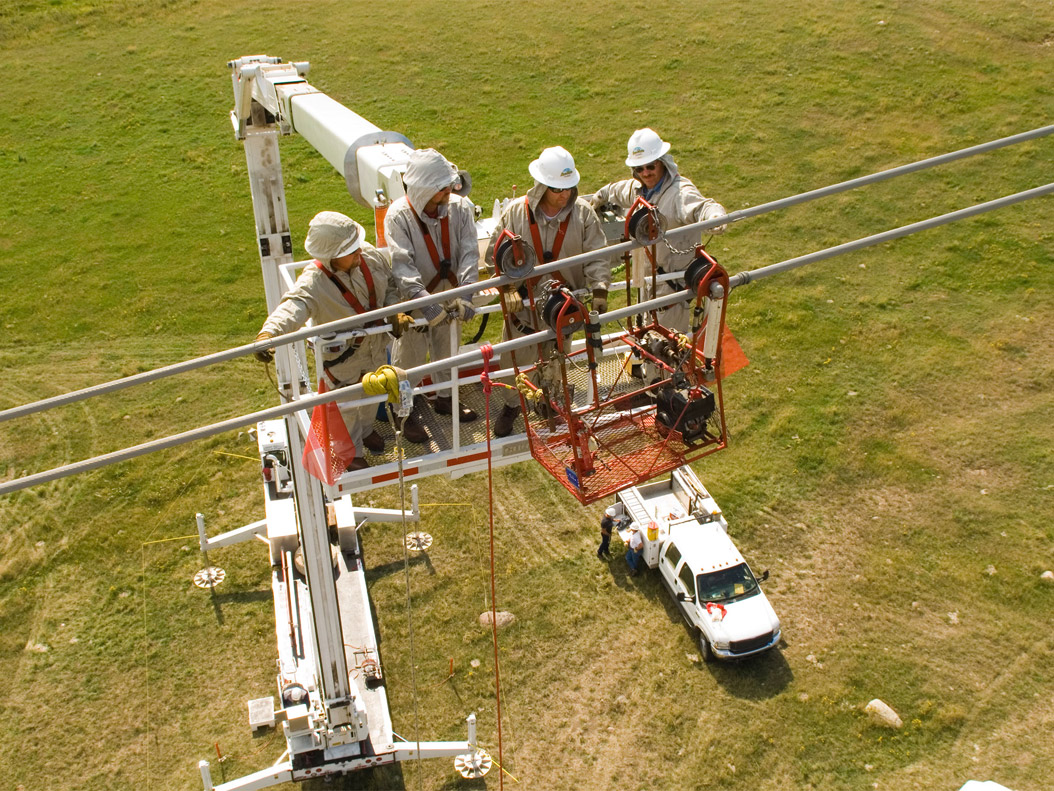 Basin Electric Linemen: Linemen work on a transmission line in North Dakota. Photo courtesy of Basin Electric Power Cooperative.
Basin Electric Linemen: Linemen work on a transmission line in North Dakota. Photo courtesy of Basin Electric Power Cooperative.- Additions to the transmission grid are needed in order to expand the wind industry, which raises the cost of new wind farms.
- Extensive research must be completed before wind turbines and wind farms can be constructed.
- Engineers must evaluate proposed sites to determine where the best wind speeds are.
- Experts must also verify that proposed sites will have minimal impact on humans and wildlife.
- Matters to be considered include migratory bird paths, environmental concerns, airports, crop dusting regions, and homes.
- Nearby homeowners could possibly be annoyed by a humming sound emitted by the turbine or a shadow flicker caused by the blades turning in front of the sun.
In the early 1980s, a large wind farm in California became operational. Unfortunately, due to poor planning and lack of knowledge in turbine design, thousands of birds were killed by their turbine blades. The California wind farm, constructed on a major bird migration route, utilized small turbines that were not designed to avoid bird collisions. Wind farms in North Dakota are located in areas appropriately sited to avoid harm to migrating birds and nesting waterfowl; and the design of modern turbines also helps minimize the risk to birds.
How wind power affects the people of North Dakota:
- North Dakota wind farms can power more than 500,000 average homes on the electrical grid.
- No air or water pollution results from wind power generation.
- The development of wind farms contributes to the economy of North Dakota.
- Nearly $5 million is paid each year to landowners who allow wind turbines to be on their land.
- Because of their small environmental "footprint," wind farms allow land to remain in agricultural use.
- North Dakota's wind industry provides jobs.
-
Some North Dakota factories make or assemble products for the wind industry.
- These include making turbine blades, and assembling turbine nacelles.
- The wind industry also offers opportunities for electricians, power line workers, and people who work in building, operating, and maintaining the turbines.
-
Some North Dakota factories make or assemble products for the wind industry.



